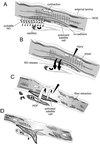A role for nitric oxide in muscle repair: nitric oxide-mediated activation of muscle satellite cells
- PMID: 10793157
- PMCID: PMC14889
- DOI: 10.1091/mbc.11.5.1859
A role for nitric oxide in muscle repair: nitric oxide-mediated activation of muscle satellite cells
Abstract
Muscle satellite cells are quiescent precursors interposed between myofibers and a sheath of external lamina. Although their activation and recruitment to cycle enable muscle repair and adaptation, the activation signal is not known. Evidence is presented that nitric oxide (NO) mediates satellite cell activation, including morphological hypertrophy and decreased adhesion in the fiber-lamina complex. Activation in vivo occurred within 1 min after injury. Cell isolation and histology showed that pharmacological inhibition of nitric oxide synthase (NOS) activity prevented the immediate injury-induced myogenic cell release and delayed the hypertrophy of satellite cells in that muscle. Transient activation of satellite cells in contralateral muscles 10 min later suggested that a circulating factor may interact with NO-mediated signaling. Interestingly, satellite cell activation in muscles of mdx dystrophic mice and NOS-I knockout mice quantitatively resembled NOS-inhibited release of normal cells, in agreement with reports of displaced and reduced NOS expression in dystrophin-deficient mdx muscle and the complete loss of NOS-I expression in knockout mice. Brief NOS inhibition in normal and mdx mice during injury produced subtle alterations in subsequent repair, including apoptosis in myotube nuclei and myotube formation inside laminar sheaths. Longer NOS inhibition delayed and restricted the extent of repair and resulted in fiber branching. A model proposes the hypothesis that NO release mediates satellite cell activation, possibly via shear-induced rapid increases in NOS activity that produce "NO transients."
Figures








References
-
- Allen RE, Temm-Grove CJ, Sheehan SM, Rice G. Skeletal muscle satellite cell cultures. Methods Cell Biol. 1998;52:155–162. - PubMed
-
- Alway SE. Overload-induced C-Myc oncoprotein is reduced in aged skeletal muscle. J Gerontol A Biol Sci Med Sci. 1997;52:B203–B211. - PubMed
-
- Anderson JE. Studies of the dynamics of skeletal muscle regeneration: the mouse came back! Biochem Cell Biol. 1998;76:13–26. - PubMed
-
- Anderson JE, Garrett K, Moor A, McIntosh L, Penner K. Dystrophy and myogenesis in the mdx diaphragm. Muscle Nerve. 1998;21:1153–1165. - PubMed
-
- Anderson JE, McIntosh LM, Poettcker R. Deflazacort but not prednisone improves muscle regeneration in mdx muscle. Muscle Nerve. 1996;19:1576–1585. - PubMed
Publication types
MeSH terms
Substances
LinkOut - more resources
Full Text Sources
Other Literature Sources
Medical
Molecular Biology Databases

